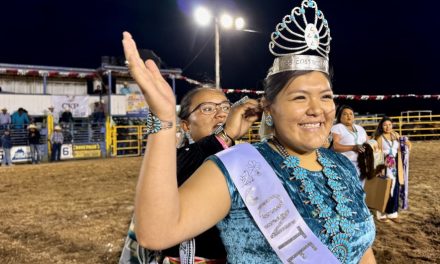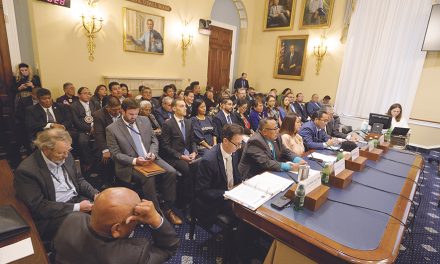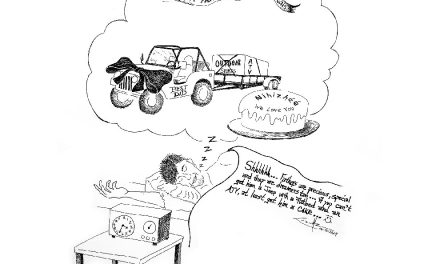
Filmmaker Deidra Peaches rousing change through visual media
By Paul Garcia
Editor’s note: Paul Garcia, Diné, is a writer based in Flagstaff.
FLAGSTAFF
Stories hold power. Since time immemorial, stories have been how people have carried their history and endowed future generations with the knowledge necessary to thrive in the ever-changing world.
It is the foundation on which people have built their culture, traditions, and society. Stories have the power to shape our future. It was this understanding that Deidre Peaches, a Diné filmmaker from Flagstaff, began her career in documentary.
“Filmmaking was a way to tell stories that are very significant to me as a Diné woman,” Peaches said. “It was also a way to bring attention to the socio-political and environmental issues that we (Diné) face on a daily basis. It’s also been a tool for me to reclaim cultural identity and a way to have a voice in media. Also, to empower the future generation to tell their own stories.”
Native filming
Peaches began her journey as a filmmaker in her formative years in middle school. From there, she studied filmmaking at Northern Arizona University, where she made her first film, “Shimasání,” which was screened at the Imaginative Film Festival in Toronto, Canada. Since then, she has remained a creative force in the Native filmmaking industry, having her films screened nationwide and in places as far away as Paris, France.
She has worked on films like “Tó éí ’iiná até,” which focused on the water scarcity in Dinétah and the groundwater contamination that was caused by uranium mining that still affects many communities today. Another film she worked on was “Journey to Alaska,” which won the Indie Film Fest Best Indie Documentary Award in 2020. During the pandemic, she covered the Navajo Nation Mananalu Relief Effort and “Yéego Diné Asdzáá,” a rock-climbing training exercise, later that same year.
Her most recent film is “Voice of the Grand Canyon,” a passion project made in conjunction with the Grand Canyon Trust. The Voices of the Grand Canyon began production in 2015 with fellow filmmaker Jake Hoyungowa.
Unfortunately, Hoyungowa passed away before the project’s completion. Despite the melancholic turn of events, Peaches continued and completed the task.
“I knew he would have wanted to finish it,” Peaches said about Hoyungowa and his commitment to the film project they began. “When he was alive, he was working with the Grand Canyon Trust and Intertribal Centennial Conversation Group. The Grand Canyon Trust approached me, and they wanted to know if I was interested in continuing this project. I felt like during that time of grief, like it was something that I needed to put my energy into because I know that’s something that meant a lot to both of us.”
Voices of the Grand Canyon highlights the tribes that still maintain historical, cultural, and spiritual connections with the Grand Canyon. Navajo, Hopi, Zuni, Havasupai, and White Mountain Apache are just some tribes that maintained a relationship with the Grand Canyon.
All of the individuals Peaches interviewed for the documentary could share a glimpse of the canyon’s significance for their tribes, and the impact colonization and industrialization have had on their connection and interaction with it. It also highlights the lack of Indigenous inclusion in ongoing projects and discussion regarding the canyon.
The film has been relatively successful since its debut. It has been nominated for several film festival awards, won the Indie Film Fest 2022 Best Documentary Grand Jury Award, and garnered media attention. While her film might be enjoying success, Peaches is in a quandary. The most significant setback to her career is the usual culprit all entrepreneurs face; securing funding.
“Getting into festivals and everything is like a whole other realm of obstacles,” Peaches said. “It just takes a lot (out of me) because sometimes the festivals require submission fees and different sorts of accommodations. I think that’s where it’s important to have a kind of network that can help in that certain way, like a production team (or sponsors). But it’s also a risk to take (sponsors) because sometimes they aren’t as committed to your (projects) as you are.”
This is an unfortunate reality for many artists. They must choose between financiers whose vision only temporarily aligns or forgoing backers entirely and relying on word of mouth and fundraising to bring their projects to fruition.
Any patron of their art can remove their support at any time without warning and leave the artist adrift without any real safety nets. Regardless of these hurdles, Peaches continues to move forward with her projects and does not intend for Voices of the Grand Canyon to be her magnum opus – the pinnacle of her career.
Magnum opus
“I’ve been doing work that was (postponed) since Covid,” Peaches said. “Just some small projects that I can’t really talk about at the moment in detail, but I can say like the work is continuing. The overall goal is to have more media created by Native people and people of color. (You’ll) have to wait for the film’s (release).”
Despite her already full plate with upcoming documentaries, Peaches has found time to focus on another one of her goals, empowering future filmmakers. She is scheduled for an appearance at the Youth Photography Workshop March 18, between 1 and 3 p.m. at the ART123 Gallery in Gallup. She has also been busy the past year cultivating the budding talents of the Kin?ání Bordertown Dormitory students in Flagstaff.
“This past year, we had a complete film program for the students (at Kin?ání),” Peaches said. “It was really cool to get the students motivated and to have them get familiar with the equipment, and not be intimidated by it but to be comfortable with (the equipment) and learning more about the intricacies of (filmmaking). There was also a program called to cultivate that focused on growing food and another program that focused on cooking.”
Last semester the programs ran simultaneously at the Colton Community Garden at the Museum of Northern Arizona. This gave the students ideal subjects to capture on film and to hone their documentary skills.
“The students got to record what’s going on, documenting the different aspects of what’s happening on the ground,” Peaches said. “They got to test out the equipment and interview each other. They got real-time learning on how to set up interviews and learn different techniques like what’s good for audio and just getting (them) comfortable with conducting an interview. They also got to really know each other during the interviews.”
Peaches is once again teaching students about cinematography this semester, and she expects the program to run until the end of this semester. She plans to make the most of her time preparing the students to become successful storytellers of their own.
“Filmmaking is a way for students to express themselves,” Peaches said. “It is very important and crucial to have that media literacy and to use media in a way that can help heal and also to help tell their own story in a way that only they know and they’re experiencing.
“It’s also a way for students to form the sense of k’é, that sense of family with one another as they work together and begin to understand one another,” she said. “And the skills they will be learning can be applied to different disciplinary fields in storytelling.”
Beyond the technical skills and storytelling prowess, Peaches hopes to impart the importance of respect and acceptance of the forces beyond their control while filming.
While it’s great that Peaches is passing down all her filmmaking knowledge and expertise, the question becomes why. Why impart all this information to the next generation? And the answer is simple and leads people full circle. Stories hold power – the power to carry history. And the ability to actively shape society on the foundation of the ancestors.









 Highway 264,
Highway 264, I-40, WB @ Winslow
I-40, WB @ Winslow